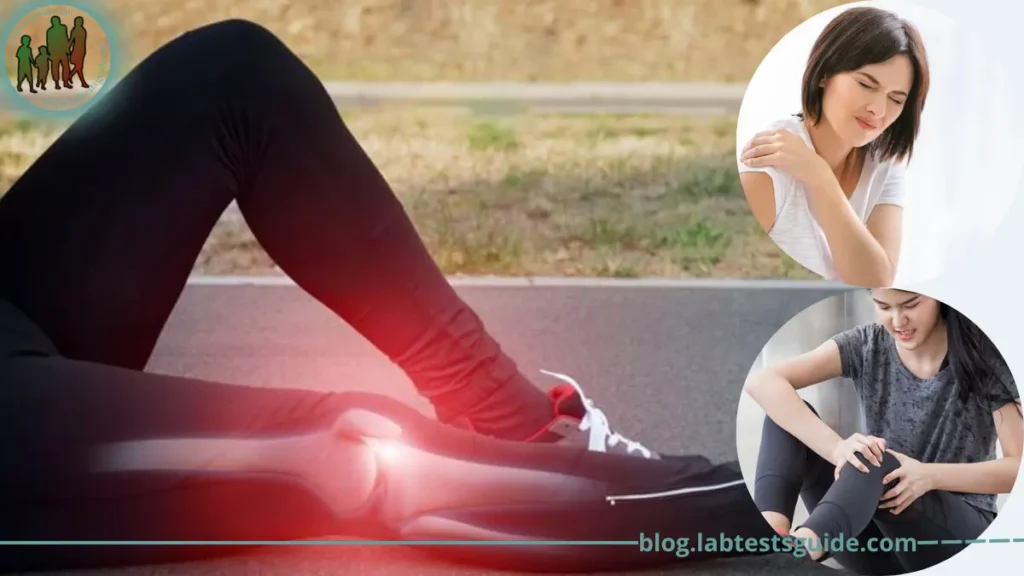Joint pain can be a common concern for women, affecting various joints in the body such as the knees, hips, wrists, and fingers. It can be caused by factors such as aging, hormonal changes, arthritis, injuries, and overuse. Managing joint pain is crucial to maintain an active and healthy lifestyle. This guide provides tips and strategies for preventing and managing joint pain specifically tailored for women. By following these recommendations, you can reduce the risk of joint pain, alleviate discomfort, and improve your overall joint health. Remember to consult with a healthcare professional for an accurate diagnosis and personalized treatment plan.

Understanding Joint Pain in Women
Joint pain refers to discomfort, inflammation, or stiffness in the joints. It can significantly impact a woman’s daily activities and quality of life. To effectively prevent and manage joint pain, it’s important to understand the factors that contribute to it in women.
- Hormonal Changes: Fluctuations in hormone levels, particularly during menstruation, pregnancy, and menopause, can affect joint health. Hormonal changes may lead to increased joint laxity, inflammation, and pain.
- Osteoarthritis: Osteoarthritis is a degenerative joint disease that commonly affects women. It occurs when the protective cartilage on the ends of bones wears down over time. Women are more prone to developing osteoarthritis due to factors such as hormonal changes, genetics, and joint structure differences.
- Rheumatoid Arthritis: Rheumatoid arthritis is an autoimmune disease that primarily affects women. It causes inflammation in the joints, leading to pain, swelling, and stiffness. Hormonal factors, genetics, and environmental triggers are believed to contribute to its development.
- Repetitive Strain: Women may engage in activities that involve repetitive movements or joint stress, such as typing, carrying heavy bags, or caring for children. These repetitive strains can contribute to joint pain and overuse injuries.
- Posture and Body Mechanics: Poor posture and incorrect body mechanics can place unnecessary stress on the joints, leading to pain and discomfort over time. Women may be more prone to postural issues due to factors like pregnancy, breastfeeding, and wearing high heels.
- Bone Health: Women are at a higher risk of developing osteoporosis, a condition characterized by weakened bones. Weakened bones are more susceptible to fractures and joint injuries, leading to pain and mobility issues.
By understanding these factors, women can take proactive measures to prevent and manage joint pain effectively. The following sections will provide tips and strategies to help women maintain healthy joints and alleviate pain.
Risk Factors for Joint Pain in Women:
Here are some common risk factors for joint pain in women.
- Age: As women age, the risk of joint pain and conditions like osteoarthritis increases. The natural wear and tear on joints over time can lead to degenerative changes and discomfort.
- Hormonal Changes: Hormonal fluctuations, particularly during pregnancy, menstruation, and menopause, can affect joint health. Hormones like estrogen play a role in maintaining joint function and integrity. Changes in hormone levels can lead to increased joint laxity, inflammation, and pain.
- Genetics: Certain genetic factors can make women more predisposed to joint pain and conditions such as rheumatoid arthritis and osteoarthritis. If there is a family history of these conditions, the risk may be higher.
- Obesity: Excess weight puts increased stress on the joints, especially the knees, hips, and ankles. This can lead to accelerated joint degeneration, inflammation, and pain. Maintaining a healthy weight is essential for reducing the risk of joint pain.
- Sedentary Lifestyle: Lack of physical activity and prolonged periods of sitting or inactivity can weaken the muscles supporting the joints. Weak muscles can contribute to joint instability and pain. Regular exercise and movement are crucial for joint health.
- Occupational Factors: Certain occupations that involve repetitive movements, heavy lifting, or prolonged standing can increase the risk of joint pain. Women in jobs such as nursing, assembly line work, or manual labor may be more susceptible to joint-related issues.
- Previous Joint Injuries: Women who have experienced previous joint injuries, such as fractures or ligament tears, may be more prone to developing joint pain in the affected areas.
- Poor Posture: Incorrect posture and body mechanics can put undue stress on the joints, leading to pain and discomfort. Poor posture habits, especially during activities like sitting, standing, and lifting, can contribute to joint pain.
- Menstrual Factors: Some women may experience increased joint pain and inflammation during their menstrual cycle. Hormonal fluctuations and the release of prostaglandins, which can affect pain perception, may contribute to this phenomenon.
By being aware of these risk factors, women can make lifestyle modifications, seek appropriate medical care, and adopt preventive measures to minimize the chances of developing joint pain. The following sections will provide tips for preventing and managing joint pain in women.
Tips for Preventing Joint Pain:
Here are some Tips for Preventing Joint Pain.
- Maintain a Healthy Weight: Excess weight puts additional stress on the joints, particularly the knees, hips, and ankles. Aim to maintain a healthy weight through a balanced diet and regular exercise to reduce the risk of joint pain.
- Stay Physically Active: Engage in regular exercise to keep your joints mobile, strengthen supporting muscles, and improve flexibility. Low-impact activities like walking, swimming, cycling, and yoga are gentle on the joints while providing numerous benefits.
- Practice Proper Posture: Maintain good posture while sitting, standing, and lifting to minimize strain on the joints. Keep your spine aligned, shoulders relaxed, and avoid slouching or hunching over.
- Avoid Repetitive Strain: Take breaks and vary your movements during activities that involve repetitive motions or joint stress. If you have a job that requires repetitive tasks, incorporate regular stretching and movement to reduce the strain on your joints.
- Protect Your Joints: When engaging in physical activities or sports, use appropriate protective gear such as knee pads, wrist guards, or supportive braces to prevent joint injuries.
- Wear Appropriate Footwear: Choose comfortable shoes with proper arch support and cushioning to minimize stress on your feet, ankles, and knees. Avoid high heels or shoes that lack adequate support.
- Stay Hydrated: Proper hydration is essential for joint health. Drink plenty of water throughout the day to keep your joints well lubricated and to maintain optimal joint function.
Remember to consult with a healthcare professional or a physical therapist for personalized advice and guidance on exercise routines, proper form, and modifications specific to your needs. These preventive measures can significantly reduce the risk of joint pain and promote overall joint health in women.
Tips for Managing Joint Pain:
Here are some Tips for Managing Joint Pain.
- Apply Heat or Cold Therapy: Applying heat packs or taking warm showers can help relax stiff joints and alleviate pain. Cold therapy, such as using ice packs, can reduce inflammation and numb the area, providing temporary relief.
- Exercise Regularly: Regular exercise is crucial for managing joint pain. Focus on low-impact exercises like swimming, walking, or cycling to maintain joint mobility, strengthen supporting muscles, and improve flexibility. Consult with a healthcare professional or a physical therapist to develop an exercise plan that suits your specific needs.
- Strengthen Muscles Around Joints: Strengthening the muscles around your joints can provide better support and stability, reducing pain and discomfort. Incorporate strength training exercises into your routine, targeting the muscles around the affected joints.
- Use Assistive Devices: Utilize assistive devices such as braces, splints, or canes to relieve pressure on the joints and improve mobility. These devices can provide support and stability, reducing pain during daily activities.
- Practice Mind-Body Techniques: Techniques such as yoga, tai chi, and meditation can help manage joint pain by promoting relaxation, reducing stress, and improving overall well-being. These practices can also improve flexibility, balance, and posture.
- Take Over-the-Counter Pain Relievers: Nonsteroidal anti-inflammatory drugs (NSAIDs) like ibuprofen or acetaminophen can help alleviate joint pain and reduce inflammation. However, consult with a healthcare professional before taking any medications, especially if you have underlying health conditions or are taking other medications.
- Consider Natural Remedies: Some natural remedies, such as turmeric, ginger, and omega-3 fatty acids, have anti-inflammatory properties that may help reduce joint pain. Discuss these options with your healthcare provider to determine if they are suitable for you.
It’s important to note that these tips are general suggestions and may not be appropriate for everyone. Always consult with a healthcare professional for an accurate diagnosis and personalized treatment plan for managing joint pain. They can provide specific guidance and recommend additional therapies or treatments based on your individual needs.
When to Seek Medical Attention
Here are some signs and symptoms that warrant a visit to a healthcare professional.
- Severe or Persistent Pain: If your joint pain is severe, getting worse over time, or persists for more than a few weeks despite self-care measures, it is advisable to consult a healthcare professional.
- Joint Swelling or Redness: If you notice significant swelling, redness, warmth, or tenderness around the affected joint, it may indicate an underlying inflammatory condition or infection that requires medical evaluation.
- Joint Deformity or Instability: If a joint appears deformed or feels unstable, it could be a sign of a more serious condition, such as a joint dislocation or ligament tear. Seek immediate medical attention if this occurs.
- Difficulty with Daily Activities: If joint pain interferes with your ability to perform everyday activities, such as walking, climbing stairs, or getting dressed, it is important to consult a healthcare professional to identify the underlying cause and develop a suitable treatment plan.
- Fever or Systemic Symptoms: If you experience fever, fatigue, unintended weight loss, or other systemic symptoms in addition to joint pain, it may indicate an underlying inflammatory or autoimmune condition that requires medical evaluation.
- Limited Range of Motion: If you have significant difficulty moving a joint or notice a decrease in your range of motion, it is recommended to seek medical attention. This could be a sign of joint damage or other underlying conditions.
- Previous Joint Injuries: If you have a history of joint injuries or surgeries and experience new or worsening joint pain, it is important to consult a healthcare professional to rule out complications or delayed healing.
- Medication Side Effects: If you are taking medications for joint pain or other conditions and experience concerning side effects or adverse reactions, consult your healthcare provider for further guidance.
Remember, a healthcare professional is best equipped to diagnose the underlying cause of joint pain and provide appropriate treatment options. They can conduct a thorough evaluation, order diagnostic tests if necessary, and recommend specific interventions to address your joint pain effectively.
Conclusion:
Joint pain can be a common concern for women, but with the right strategies, it is possible to prevent and manage it effectively. By understanding the risk factors and implementing preventive measures such as maintaining a healthy weight, staying physically active, practicing proper posture, and protecting your joints, you can reduce the likelihood of experiencing joint pain. If you do experience joint pain, incorporating techniques like heat or cold therapy, regular exercise, muscle strengthening, and the use of assistive devices can help manage the pain and improve joint function. However, it is important to know when to seek medical attention, especially if the pain is severe, persistent, or accompanied by other concerning symptoms. Consulting a healthcare professional will ensure an accurate diagnosis and personalized treatment plan for your specific needs. Take care of your joints, listen to your body, and prioritize your joint health to lead an active and pain-free life as a woman.






